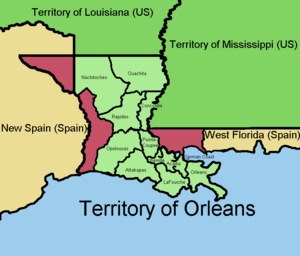Attakapas County, Orleans Territory facts for kids
Attakapas Parish was an old area, like a county, in southern Louisiana. It was one of the first twelve "parishes" (which are like counties) created after the United States bought the Louisiana Territory in 1803. The main part of Attakapas Parish was a trading post called Poste des Attakapas. This trading post later grew into the city we know today as St. Martinville.
Contents
How Attakapas Parish Was Formed
Attakapas Parish was officially created in 1805. Governor William C. C. Claiborne formed it from two areas called the Attakapas and Opelousas districts. This new parish was shaped like a triangle. It stretched from the Mermentau River in the west to the Atchafalaya River in the east, all the way down to the Gulf of Mexico in the south.
Over time, as more people moved into the area, Attakapas Parish was divided into smaller parts. In 1811, it was split into St. Martin and St. Mary parishes. Later, as the population grew even more, new parishes were created from this region. These included Lafayette Parish in 1823, Vermilion Parish in 1844, and Iberia Parish in 1868.
Early History of the Region
Before Europeans arrived, the land that became Attakapas Parish was mainly home to the Atakapa tribe. They lived there for many years.
European Settlers Arrive
The first Europeans came to this area in the 1730s. Most of these early settlers were French or had French backgrounds.
In the 1760s and 1780s, big changes happened. Britain won a war against France called the Seven Years' War. Because of this, Britain took over French lands in North America, east of the Mississippi River. The British also forced many Acadian people to leave their homes in Nova Scotia. Some Acadians moved to different places, including other British or French areas.
In 1765, a leader named Joseph Broussard, also known as Beausoleil, brought about 193 Acadians to settle in the Attakapas District. These Acadians had fought against the British in Canada. They settled in the area between where Breaux Bridge and Loreauville are today. This happened two years after France had given most of its Louisiana colony to Spain. Even so, the French governor was still in charge of the territory at that time.
These first Acadian settlers helped their relatives who were spread out in other places. They created a place where more Acadians could come and settle later, once they had enough money and permission to travel.
Life and Culture in Attakapas
By the time Attakapas became an official parish, the Acadian settlers had built a successful farming economy. They raised a lot of cattle and also grew vegetables and corn. To help with this work, they used the labor of enslaved African Americans. In 1803, a count of the Attakapas District showed there were 2,270 white people, 210 free people of color, and 1,266 enslaved people. In total, there were 3,746 people living there.
This region became very important for both Cajun culture and Creole culture in Louisiana. Both European Americans and African Americans in the area often followed the Catholic faith. They also shared French-influenced language and culture. Over time, they also adopted and shared parts of African American and Native American cultures, including different types of food.


